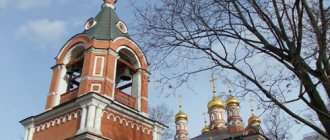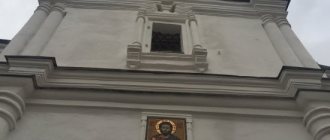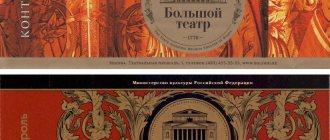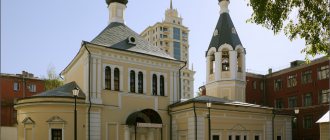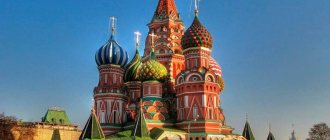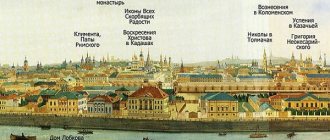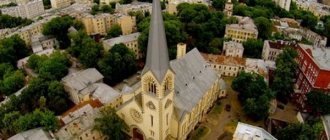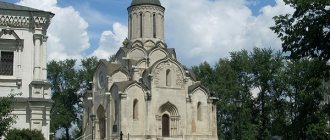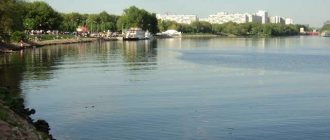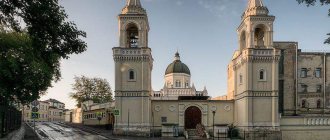For the first time current Church of St. John the Warrior on Yakimanka mentioned in 1625. Then it stood on the bank of the river, so it was often flooded.
According to legend, while passing through this place, Peter I noticed a church that could only be reached by boat.
Having learned that this was a shrine in the name of John the Warrior, the king was very indignant and ordered the construction of a new stone building instead of the old one, and to place the temple on a hill next to Bolshaya Street.
In 1709, construction of the temple began and lasted about 8 years.
Photo 1. Ancient temple in the name of John the Warrior on Yakimanka in Moscow
Story
The very first mention of the Church of St. John the Warrior dates back to 1625. Then it was located on the banks of the Moscow River, closer to the Crimean Bridge, approximately where the territory of the Central House of Artists (CHA) and the intersection of Yakimansky and 2nd Babyegorodsky lanes begins and was called the Church of John the Warrior “that is at the Crimean Courtyard on the shore.” John the Warrior, or as they used to say, the Warrior, was the patron saint of the archer warriors who lived at that time in this place since the 1550s by order of Tsar Ivan the Terrible. The church was located “under the mountain” and river floods often flooded it. In general, this entire area was heavily flooded until the construction of the Vodootvodny Canal in 1786.
Through the efforts of the archers, the construction of a new stone church began. In 1671 the temple was rebuilt, but did not last long. After the Streltsy uprising, the surviving Streltsy and their families were evicted from Moscow, the temple was abandoned, and in 1708 it was flooded during a flood.
In 1709, according to an eyewitness of the events, “the water was great in Moscow, it came under the stone bridge, under the windows, and carried away courtyards from the banks, with mansions and people, and drowned many people, also many churches and those of John the Warrior for The Moscow River drowned the Church of God.”
1882
In 1712, a vacant lot and several courtyards, also from Streltsy quitrent lands, were allocated for the church cemetery. The Moscow governor, Prince Mikhail Grigorievich Romodanovsky, canceled the payment of quitrent money from these lands, and ordered the owners to pay only “bridge money” - to put the roads in order near their properties. After some time, the new governor, boyar Alexei Petrovich Saltykov, ordered the collection of quitrent money. Thus, arrears arose behind the Church of St. John the Warrior (from 1714 to 1720): 89 rubles, 22 altyns, 2 quitrent money and 24 pavement rubles.
For the consecration of the temple in 1717, Peter the Great sent golden vessels, a painting and a pound weight on a massive chain. It was hung at the entrance to remind people to maintain order during the service. The painting, which was more than two arshins in length and width (about 142 cm), had the inscription at the top: “A pharmacy that heals sins.”
However, there is every reason to believe that the construction of the Temple was planned earlier in a new location: thus, for the construction of a new church, land was purchased back in 1702 from Streltsy quitrent lands. But, apparently, it was the desire and finances of Peter the Great that prompted the start of construction of the Temple of St. John the Warrior.
The author of the plan and its architect was one of the favorite architects of Peter I, Ivan Petrovich Zarudny (born 1727). Already on June 11 (23), 1711, the chapel of St. was consecrated in the southeastern corner. martyrs and confessors Guria, Samon and Aviv (November 15/28) and divine services began in the Temple.
The great consecration of the Temple on June 12, 1717 was performed by the Patriarchal Locum Tenens Metropolitan of Ryazan and Murom Stefan (Yavorsky). From this day, which is considered the beginning of the life of the new Temple, according to the profound remark of Father Nazarius, abbot of Valaam, “the guardian angel of the Throne of the Lord constantly dwells in the temple of God.”
A document from 1721 has been preserved, according to which the priest Alexei Fedorov bought for 5 rubles from the widow of the guard of the Uniform Chancellery Agafya Potapovna Chertikhina her buildings (probably a house and outbuildings), located near the church on Bolshaya Kaluzhskaya (that was the name of Yakimanka in those years). She “ceded over the land on which all this was located to the Church of John the Warlord for the construction of an almshouse on it.” Thus, along with Peter the Great, priest Alexei Fedorov should be recognized as the founder of the new Church of John the Warrior.
In 1752, a significant event took place in the history of Orthodox Russia - the relics of St. Dmitry of Rostov were found incorrupt and later canonized (comm. September 21/October 4 and October 28/November 10). The year of the saint's presentation coincided with the year of the foundation of the Church of St. Martyr John the Warrior. The burial of the Saint, his deceased friend, was performed by the same Metropolitan of Ryazan and Murom Stefan (Yavorsky), who consecrated the Temple. The life of the newly-minted Saint and the Temple thus proceeded almost simultaneously and spiritually interconnected. The interweaving of dates and events prompted parishioners to ask to consecrate a new altar in the name of this saint.
Thus, in 1760 the Church of St. Martyr John the Warrior became three-throne.
In 1812, during the invasion of Napoleon, the Church of St. Martyr John the Warrior was desecrated by the French.
The Lord also saved the Temple from fire: the flames raging on Yakimanka stopped when they reached the church fence. The temple and the entire right side of the street up to the Kaluga Gate (where Kaluga Square is now) remained outside the fire.
After the enemy, the thrones were consecrated anew: St. Guria, Samona and Aviva - February 20, St. Demetrius of Rostov - March 9, St. John the Warrior - June 29, 1813. The few days when the Temple was looted remained the only days in the entire 300-year history of the Temple when no services were held in it.
Thanks to generous donations and precious contributions, the Temple gradually restored its utensils and interior decoration and by 1840 it had reached its former splendor.
During the years of fighting against God, the Temple, by the will of God, was destined to become one of the few centers of true Orthodoxy in Moscow. In 1922, for loyalty to Patriarch Tikhon and his duty, the rector of the Temple and Dean of Zamoskvorechye, Fr. Christopher (Nadezhdin). In the 90s he was glorified as a schmich. Christopher. Today, the parishioners of the Temple pray to him for the granting of firmness in faith.
Prayers sschmch. Christopher and all the heavenly patrons, the Temple managed to avoid the taint of renovationism and remain faithful to the canonical hierarchy. Throughout the years and to this day, services have been and are being performed in accordance with the historical Orthodox tradition.
The temple did not close, but in 1922 church utensils and other valuables were confiscated from it.
The Temple also had another obedience - to become the custodian of many great Christian shrines, transferred to the Temple in the 20-30s from closed Moscow churches. This is an icon of the righteous Joachim and Anna with 80 hagiographic stamps from the church that gave the name to Yakimanka street, and an icon of St. St. Basil's from the temple named after him on Red Square, and the relics and icon of St. Great Martyr Barbara from the church named after her on Varvarka.
The icons of the All-Merciful Savior of Smolensk and St. Nicholas the Wonderworker were previously located above the gates of the Moscow Kremlin, which received their names from them.
The existing beautiful carved gilded iconostasis was built in 1708 for the Church of the Three Saints at the Red Gate and transferred from there to the Church of St. Martyr John the Warrior in 1928, when the Church of the Three Saints was demolished.
One of the last changes to the Temple of St. John the Warrior was in 1984, when, due to the expansion of the street, the church fence, erected in 1746-58, was moved to a new red line.
Information for pilgrims
Pilgrims can visit the Church of St. John the Warrior on Yakimanka at any time, but they should be guided by the schedule of services, which is posted on the temple’s website. There is a children's Sunday school on site, which also hosts excursions and demonstration performances.
Since April 2021, Gospel conversations have been held regularly on Sundays in the church library for parishioners and pilgrims. The conversation is held in the format of a tea party, where everyone present is both a listener and a teacher. Participants take turns reading a passage from the Bible and moving on to discuss it.
The “Owl” Theater Studio operates at the temple, where children often perform performances for pilgrims, as well as in honor of Orthodox holidays. Children actively take part in competitions and win prizes. A children's choir is also organized.
Every month the temple schedules services for its parishioners and pilgrims.
During Easter week, everyone can climb the bell tower and try their hand at being a bell ringer. The Orthodox Church of St. John the Warrior itself actively takes part in religious processions and excursions to holy places. The abbots of the temple conduct historical lectures.
Each parishioner can bring unwanted clothes to the church, and they will be given to those in need or to a boarding home. The temple named after this saint is located not only in Moscow on Yakimanka, but also in Chelyabinsk, Kovrov, Novokuznetsk, Bryansk and Vladikavkaz.
The temple has its own website, where all events and innovations are recorded . There every parishioner can find out all the information he is interested in. A tour of the temple can be booked at any travel agency that deals with local attractions in Moscow.
The most popular excursion is led by Dmitry Polyakov. The route passes through several places: the path begins from Bolshaya Yakimanka, passes along Yakimansky Proezd, Golutvinsky Lane and ends with the Church of St. John the Warrior. The route lasts about 2.5 hours. The next excursion date is March 8, starting at 11:00. Free admission.
In the book “The Temple of the Holy Martyr John the Warrior on Yakimanka in Moscow,” you can study in detail the history of the temple. This book was written in 2011 with the assistance of Father Superior Nikolai Smirnov (died 2015).
The temple has an electronic application service for prayer; a card to fill out can also be found on the website. For questions about organizing pilgrimage excursions and accommodation, you can contact directly the rector of the Church of St. John the Warrior on Yakimanka or write your question on the temple’s website. The temple also has accounts on several social networks where you can communicate and ask questions.
Article design: Oleg Lozinsky
Current state
Description
Iconostasis
The architecture of the building combines elements of the Moscow Baroque styles with the Ukrainian Baroque, and the European influence common in Russian architecture during the time of Peter. The architect remained unknown; the resemblance to the Menshikov Tower suggests the work of Ivan Zarudny. The main building is a traditional Moscow octagon in a square (an octagon on a quadrangle), however, in this case there are two coaxial octagons, each crowning half of the dome.
Temple activities
The church operates a children's Sunday school, a youth club, and a point for distributing things to the homeless. The parish of the temple periodically provides charitable, financial and material assistance to a special (correctional) general education boarding school in the city of Kashin, Tver region.
Architect and exterior decoration of the temple
Since the restoration of the temple was initiated by Peter I, the reconstruction was carried out by his architectural favorite - Ivan Zarudny, who was the author of several large-scale buildings. The exterior decoration is made in the Russian-Ukrainian Baroque style, characteristic of all projects of Ivan Zarudny. The construction was carried out according to the “temple-refectory-bell tower” scheme.
The Temple of St. John the Warrior is a landmark project.
In general, the external decoration of the temple is typical of the Moscow style of those times, but the European influence is also noticeable, which was characteristic of the era of Peter I. The facade of the building is decorated in bright colors. The cornices end in a semicircle. And the bells have a special sound in this temple. Yakimanka is decorated with a carved black fence of the Temple of St. John the Warrior, and the area is also landscaped with trees.
Shrines
- Icon of the Mother of God of Vladimir with stamps
- Martyr icon. Guria, Samona and Aviva
- Martyr icon. John the Warrior with his life
- Icon of the right Joachim and Anna
- Icon and part of a finger with a military service ring. Barbarians
- Icon of St. St. Basil's
- Image of the Savior of Smolensk
- Image of St. Nicholas
- Icon of St. Anna Kashinskaya with a particle of her relics
- Icon of St. Seraphim of Sarov with a particle of relics
- Particles of over 150 saints of God in arks and icons
- Analog icon sschmch. Christopher (Nadezhdin), former rector of the Church of St. John the Warrior on Yakimanka
How to get there by public transport
From Red Square you can quickly get to the Church of St. John the Warrior by public transport. Buses and minibuses travel regularly to Bolshaya Yakimanka.
The route will be as follows:
- From Red Square you need to walk about 600 m to the bus stop.
- On the square The M1 bus stops at Manezhnaya, on which you need to travel 6 stops (the fare is 55 rubles).
- Having reached the station. Oktyabrskaya metro station, you need to walk about 170 m along the street. Bolshaya Yakimanka to the side is stupid. Crimean.
